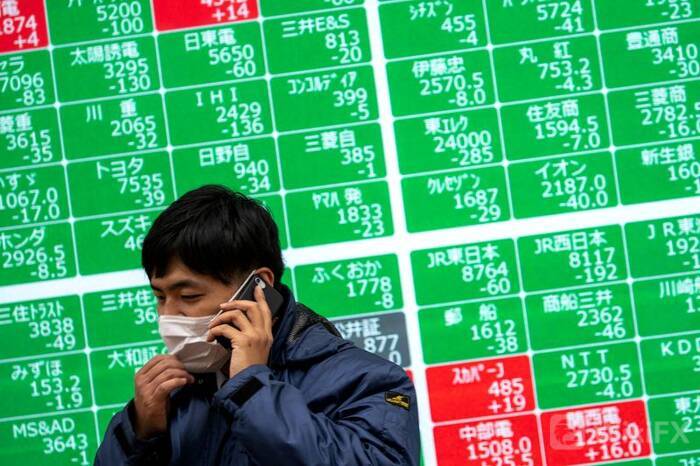Stocks made a wobbly start to the week while oil and the euro were under pressure on Monday, as the return of COVID-19 restrictions in Europe and talk about hastened tapering from the U.S. Federal Reserve put investors on guard.
Oil futures skidded about 1% to seven-week lows early in the Asia session, before recovering a little. [O/R]
MSCIs broadest index of Asia-Pacific shares outside Japan fell 0.1%. Futures steadied after selling on Friday and EuroSTOXX 50 futures were up 0.2% and S&P 500 futures up 0.3%.
Austria began its fourth lockdown on Monday, with neighbouring Germany warning it may follow suit, shutting Christmas markets, bars, cafes and theatres.
“There are question marks over the resilience of Europe and the European economy,” said Rodrigo Catril, a strategist at National Australia Bank in Sydney.
“Its hard to see the U.S. dollar coming to any harm against that backdrop,” he said, a view further underlined by recent strong U.S. data and hawkish remarks from Fed officials.
The euro slipped 0.2% to $1.1280, close to a 16-month low. The common currency has been the prime mover in markets over recent sessions as investors wager on Europes economy lagging well behind the U.S. recovery. [FRX/]
Safe-haven assets such as bonds, gold and the yen have also benefited from the recent cautious tone.
On Monday, the yield on benchmark 10-year U.S. Treasuries was steady at 1.5600%. Gold found support at $1,845 an ounce. The yen hovered at 114.09 per dollar.
Chipmakers stood out as gaining against the tide, on a brightened demand outlook, helping Japan‘s Nikkei stay steady and lifting South Korea’s Kospi by 1%. Samsung and SK Hynix each rose by more than 5%.
HAVEN PLAYS
Trade is likely to be thinned this week by Thanksgiving in the United States, but the virus‘ resurgence has traders once again monitoring COVID-19 cases and governments’ responses.
Central bank speakers are also in focus this week, while surveys in Europe and Britain through are expected to show a downward trend in output and sentiment.
Demand worries just as China, Japan and the United States mull releasing stockpiled oil have now pushed benchmark Brent futures – sometimes a bellwether for growth – to $78.69 a barrel, down about 9% from last months three-year high.
“The combination of COVID, growth and geopolitical concerns in the euro zone is supportive of safe-haven plays,” said Rabobanks head of FX strategy Jane Foley.
“The recent break below the EUR/USD $1.15 level and the lurch downwards that followed has forced us to lower our forecasts for the currency pair further,” she added, expecting it to sit around $1.12 by mid next year.
Meanwhile the U.S. economy has been surprising analysts with stronger-than-expected retail sales data and hot inflation in recent weeks. The focus this week is on prices and the labour market and on what the Fed might do about their strength.
Fed Vice Chair Richard Clarida said last week that quickening the pace of tapering might be worth discussing at Decembers meeting. November meeting minutes are due Wednesday.
China stood pat on its benchmark lending rates on Monday, as expected, and the yuan firmed even though signs of official discomfort at its strength seem to grow. [CNY/]
Central banks in South Korea and New Zealand are expected to hike rates this week, with swaps markets priced for about a 40% chance of a 50 basis point rate hike in New Zealand.
Bitcoin was under pressure after posting its worst week in two months last week and fell 3% to $57,000.
In emerging markets, Turkey‘s crashing currency has been generating nerves, but on Monday the lira attempted a bounce from last week’s record low and was last up about 2% at 11.02 per dollar.
(Reporting by Tom Westbrook in Sydney; Additional reporting by Joori Roh in Seoul; Editing by Himani Sarkar and Lincoln Feast.)

Leave a Reply